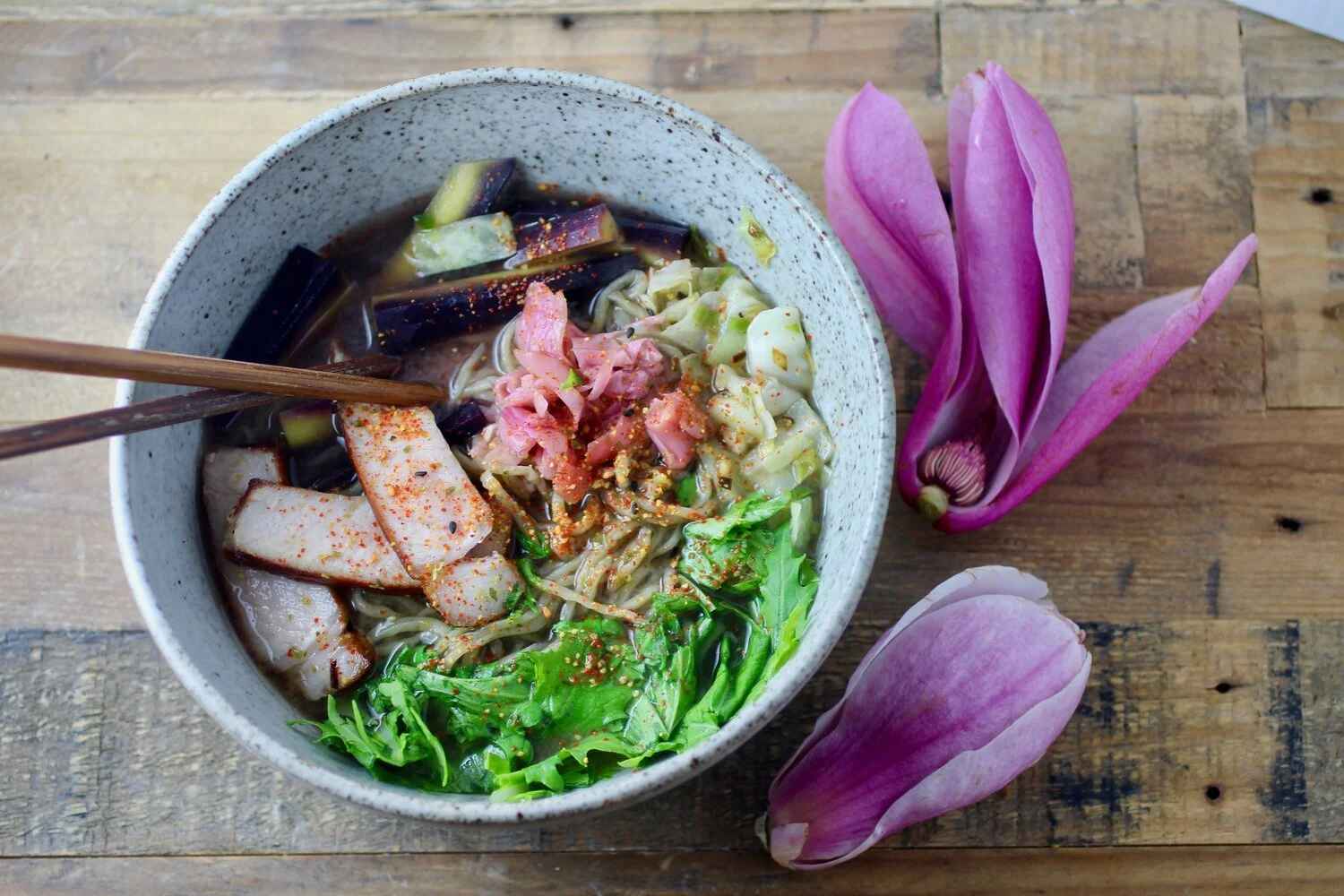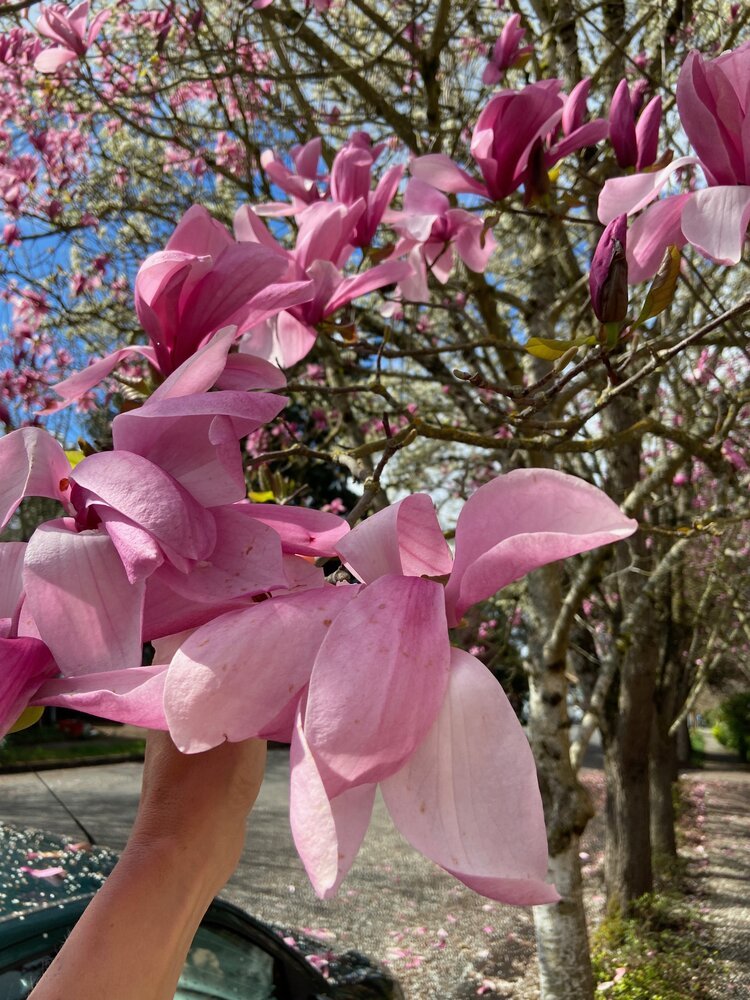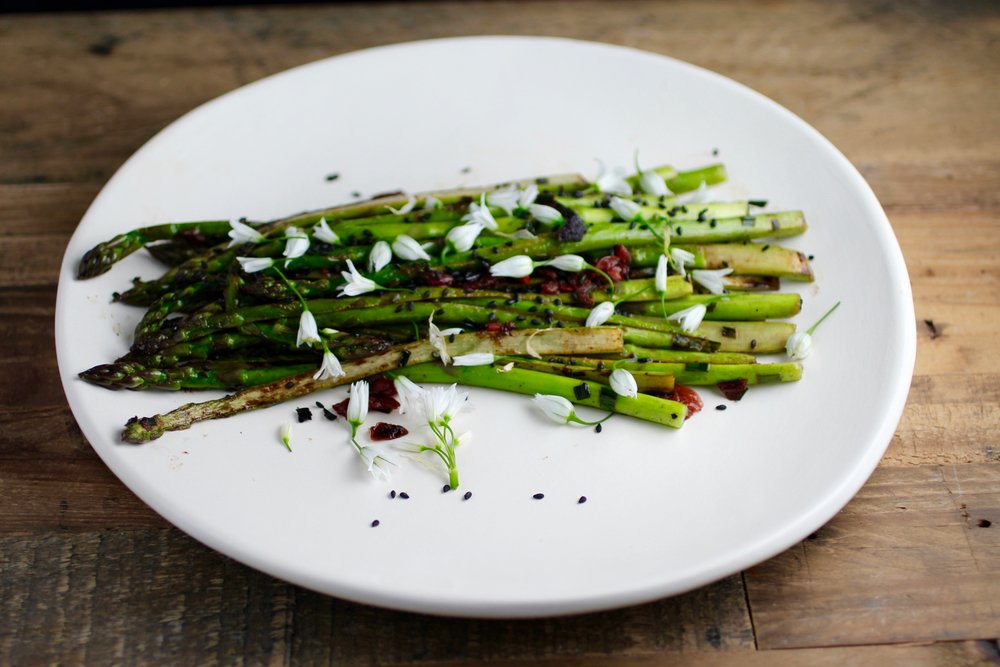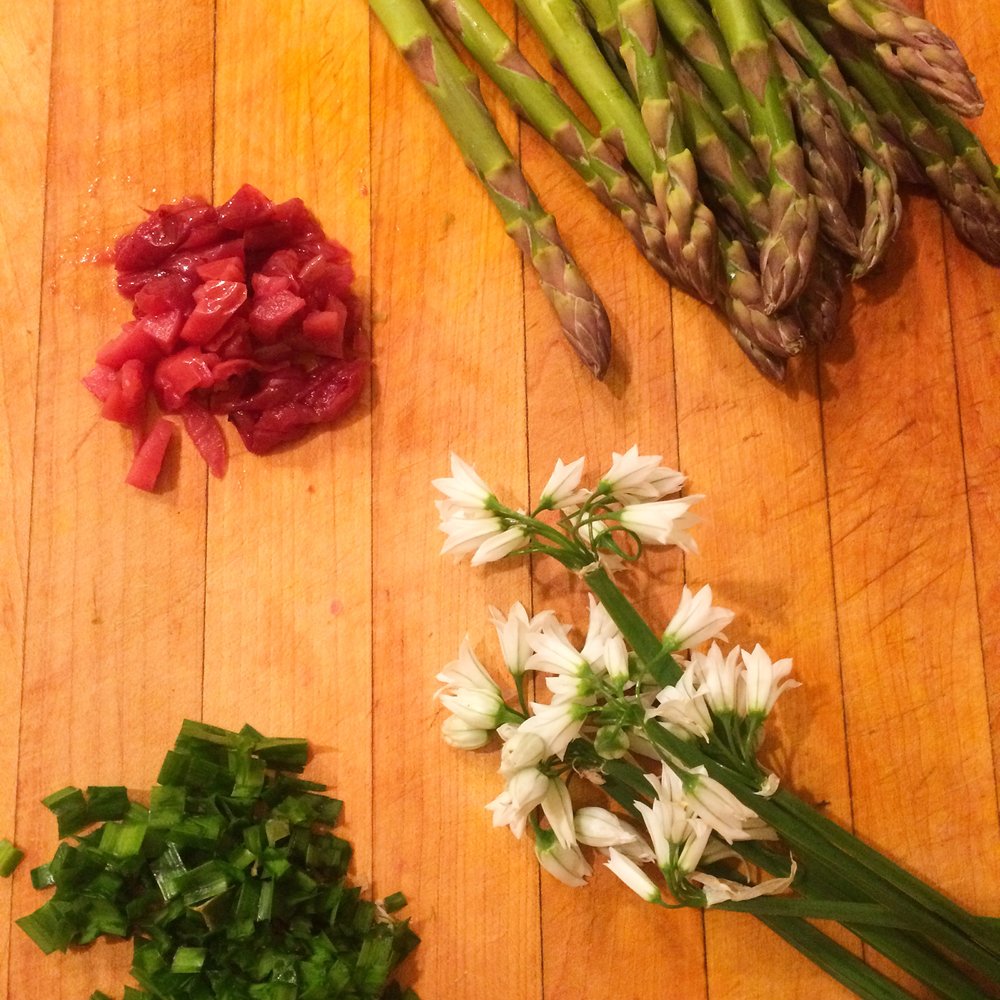Pickled Magnolia Blossoms
Pickled magnolia blossoms
Fresh and pickled magnolia blossoms.
When magnolia trees bloom, they aren’t shy about it - they burst forth in seductive, fragrant glory and leave a slew of thick, oxidizing, hard-to-clean-up flowers in their wake. I love them for this and was pleasantly surprised to find out that the blossoms are also edible. Let’s be honest, these past two (pandemic) springs has been surreal and anxiety-provoking, so having an excuse to go outside and work on a foraging project is and was definitely appreciated. Most magnolias bloom in the spring and all varieties of Magnolias are edible - star magnolia, saucer magnolia, lily magnolia - you name it. The blossoms have variations in color/flavor/texture, so I’d recommend tasting a sliver and seeing what works best for you. Fresh, they have a texture similar to endive with a spicy/floral flavor.
Uses: Prior to this experiment, I’d only used fresh magnolia petals to top desserts, more for decorative purposes than anything. But, you can also use them in small amounts in salads/grain bowls/etc. or they can be pickled, which is the most common application. I would like to try infusing a liquor with them as well, but haven’t gotten around to that yet! Any time you handle the flowers (if you care at all about their appearance) it’s important to be very careful, as the petals bruise/brown easily.
Gorgeous magnolia blossom - for eating raw, the younger leaves are best.
Pickled Magnolia Blossoms: This recipe is an adaptation/combination of two recipes I found (shoutout Medium and eatweeds.co.uk) along with what seemed like it would work and taste the best to me. You can liken the final product to a strong/very floral pickled ginger (with an appearance/texture to match). As you might guess, they work really great with Japanese/Asian flavors like sesame, soy, and seaweed - I’ve used them in a miso noodle bowl (pictured below) and am looking forward to trying it out in a brown rice/sesame bowl or maybe with some homemade sushi/salmon? I could see pickled magnolia being great in any application where pickled ginger sounds good, but also creamy foods to counter the spicy like a compound butter or mild fresh cheeses. The vinegar can be used as you would use regular vinegar as well - for both petals and vinegar, a little goes a long way. Below recipe makes about 1 cup.
220g magnolia flowers (about 6-7 cups packed) - For pickling, it’s ok to have older leaves. For eating fresh you want the younger nicer leaves.
500mL rice vinegar (about 2-¼ cups) - Other light-bodied vinegars or a combination also works, I see a lot of people use apple cider vinegar, but I wanted the subtlety of the rice vinegar.
110g granulated sugar (about ½ cup)
2 teaspoons Kosher salt
To Prepare
Clean and dry flowers - carefully so you don’t bruise the petals.
Add petals to a quart jar or two pint jars (pack tightly). Naturally, jars should be clean.
Heat vinegar with sugar and salt to simmer and sugar/salt is dissolved, stirring as needing.
Pour hot brine over petals.
Using a clean spoon or other utensil, submerge petals under brine several times as they inevitably rise to the top. Optional: I like to use a clean plastic bag or smaller mason jar with a little water to make sure the petals stay submerged.
Cover with lid, allow to come to room temperature, then refrigerate.
Pickled blossoms are ready in 24 hours and will keep in the refrigerator for 4 months to 1 year (still looking into this as I keep them in my fridge - I know that the color will become browner).
Pickled magnolia blossoms in a bowl of miso-ramen.
Asparagus-Wild Onion-Umami
Asparagus-Wild Onion-Umami
One of my favorite spoils of spring are the wild onions. In the Bay Area, the Allium triquetrum or "three-cornered leek" is the wild onion that abounds and it also happens to be as lovely in flavor as it is in appearance. This wild onion is nicknamed "three-cornered" because of the shape of its stems and has the characteristic allium smell and taste with a delicate sweet note, especially when using its small, white, star-shaped flowers.
There are many ways to enjoy these "three-cornered leeks", but pairing them with asparagus deliciously highlights the season. In California, not many foods are truly seasonal so when they are I like to indulge. Browning the asparagus and chopped onion stems in butter with umeboshi brings in umami elements then topping with the sweet wild flowers and crunchy bits of sesame really knocks it out of the park. We made umeboshi last year with local wild plums, but store bought umeboshi or even miso can be used as a substitute if you do not have access to umeboshi - either ingredient will contribute the umami flavor that you're looking for. Recipe is adaptable to the amount of asparagus you have preference for strength of flavors. The below recipe will serve 2-4 people (in our house, definitely only 2!)
1 pound of asparagus (about 16 spears), tough fibrous stems removed
7 wild onion, aka three-cornered leek, stalks with flowers (there will be several flowers on each stalk)
1 tablespoon unsalted butter
3 umeboshi, finely chopped, or 1 tablespoon red or brown miso
1 tablespoon sesame seeds
For larger asparagus spears: Using a vegetable peeler, peel bottom of spear about 1-inch up from bottom and slice larger asparagus spears in half lengthwise. If you have thin asparagus spears, both of these steps can be skipped.
Remove wild onion flowers and dice stalks. Set aside.
In a cast iron pan, sauté butter over medium-high heat. Add asparagus, toss to coat, and cook until beginning to soften, about 1 minute. Add umeboshi (or miso in small pieces) and diced wild onion stalks, toss to coat, and cook until asparagus browns, about 3-5 minutes, tossing halfway through. Test an asparagus spear to see if it is flavored to your liking - if not, add more butter/umeboshi or miso/onion.
Remove from heat and top with sesame seeds and wild onion flowers. Serve hot.
Wild onion basking in the sun.
Spring Frittata with Asparagus, Leeks, and Chèvre
Spring sprung into a cast iron pan.
Celebrate spring by including asparagus and the bright flavors of goat cheese and tarragon in this elegant and satisfying meal. Frittata is a very easy way to whip up a stylish breakfast that’s also very durable and adaptable to a variety of dietary needs (well, apart from vegan that is, as eggs are necessary). This will solve your weekend brunch needs - don't worry, next weekend is just around the corner! Serves 6.
10 eggs
2 tablespoons fresh thyme leaves
1/2 teaspoon salt
1/4 teaspoon coarse ground black pepper
1 tablespoon unsalted butter
2 tablespoons olive oil
1 medium leek, trimmed and thinly sliced (use whites and greens)
16 asparagus spears, ends trimmed and chopped into 1.5-inch pieces
4-6 ounces chèvre (fresh goat cheese), crumbled
Preheat the broiler to high. Whisk eggs with thyme, salt, and pepper. Set aside.
Heat butter and oil in a large oven-proof pan over medium-high heat. Add leeks and cook, stirring occasionally, until softened, about 3 minutes. Mix in asparagus and continue to cook another 2-3 minutes until asparagus is slightly softened but still bright green.

Pour egg mixture over asparagus, stir once just to ensure even distribution of ingredients, and cook about 2 minutes, until almost set. Sprinkle with crumbled chèvre and broil frittata in the pan until golden brown, about 3-5 minutes (check and rotate if one side is cooking faster). Remove from oven and serve from pan or slide frittata onto a plate.
Caldo Verde Verde
An even greener spin on an already green soup.

Caldo verde is a traditional Portuguese soup made from potato, chorizo, garlic, and a bunch of leafy greens, such as kale or chard (there’s no reason why you couldn’t use all or partial amount wild greens here either). In this spin, I include even more greens to the recipe by way of parsley and cilantro to give it just a bit more brightness, complexity, and of course, to make it even greener. March is a great time to get into green!
A few friends and I have been doing what we call "#craftsoup" nights where the host prepares soup and everyone crafts as they eat. The purpose of soup is a meal that's easy for the host and easy to eat while you're crafting. I'm always on the lookout for soups to prepare for these nights that are simple, quick, crowd-pleasing, and a complete meal in themselves (one of the rules of #craftsoup night is the host doesn't make anything beyond soup, though I break that rule often). This meal definitely checks all of these boxes and any soup that includes a pound of green leafy vegetables while tasting rich and satisfying has my vote! Serves 4 as a main course, 6-8 as a side.

“The soup can be “veganized” by using sautéed mushrooms instead of the chorizo and replacing butter with olive oil. ”
1 tablespoon extra-virgin olive oil, plus more for drizzling
1 tablespoon unsalted butter
3 garlic cloves, diced
1 large yellow onion, chopped
4-5 ounces chorizo (I like to use Palacios brand purchased at Berkeley Bowl), sliced 1/4 inch thick
2 cups water
2 cups chicken stock
3-4 Yukon Gold potatoes (about 1.25 pounds total) chopped
2 teaspoons white pepper (preferably freshly ground)
Salt to taste
1 pound Red Russian kale (about 1 large bunch), stems discarded and leaves finely sliced - no reason why you couldn’t use wild greens such as dandelion or dock here.
1/2 cup combination of fresh parsley and cilantro, diced (cilantro can be replaced by parsley for the cilantro-haters out there)
Heat the tablespoon of olive oil and butter in a large pot on medium low. Add the garlic, onion and half of the chorizo and cook, stirring occasionally, until the onion softens, about 6 minutes.
Add the water, broth, and potatoes and bring to a boil. Simmer until the potatoes are tender, about 15 minutes.

A great trick for chopping the greens into thin strips is to layer the leaves, roll up, and chop multiple leaves at the same time.
Using an immersion blender, purée the soup and add white pepper and salt to taste. Bring the soup to a boil. Add the kale and remaining chorizo (reserving a few pieces of chorizo for garnish) and simmer until the kale is wilted, about 3 minutes. Just before serving, stir in herbs, drizzle with olive oil and garnish with chorizo and herb sprig.
Serve with: Buttermilk cornbread

















